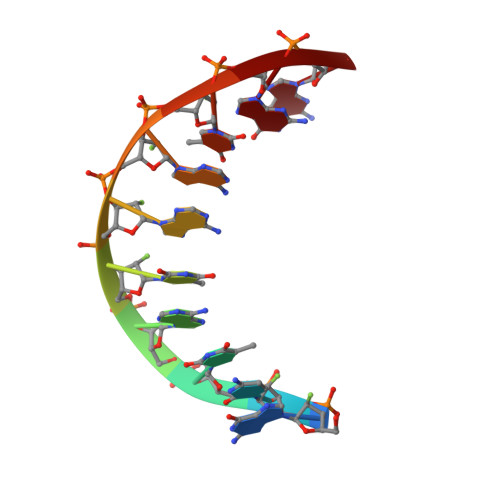Differential stability of 2'F-ANA*RNA and ANA*RNA hybrid duplexes: roles of structure, pseudohydrogen bonding, hydration, ion uptake and flexibility.
Watts, J.K., Martin-Pintado, N., Gomez-Pinto, I., Schwartzentruber, J., Portella, G., Orozco, M., Gonzalez, C., Damha, M.J.(2010) Nucleic Acids Res 38: 2498-2511
- PubMed: 20071751
- DOI: https://doi.org/10.1093/nar/gkp1225
- Primary Citation of Related Structures:
2KP3, 2KP4 - PubMed Abstract:
Hybrids of RNA with arabinonucleic acids 2'F-ANA and ANA have very similar structures but strikingly different thermal stabilities. We now present a thorough study combining NMR and other biophysical methods together with state-of-the-art theoretical calculations on a fully modified 10-mer hybrid duplex. Comparison between the solution structure of 2'F-ANA*RNA and ANA*RNA hybrids indicates that the increased binding affinity of 2'F-ANA is related to several subtle differences, most importantly a favorable pseudohydrogen bond (2'F-purine H8) which contrasts with unfavorable 2'-OH-nucleobase steric interactions in the case of ANA. While both 2'F-ANA and ANA strands maintained conformations in the southern/eastern sugar pucker range, the 2'F-ANA strand's structure was more compatible with the A-like structure of a hybrid duplex. No dramatic differences are found in terms of relative hydration for the two hybrids, but the ANA*RNA duplex showed lower uptake of counterions than its 2'F-ANA*RNA counterpart. Finally, while the two hybrid duplexes are of similar rigidities, 2'F-ANA single strands may be more suitably preorganized for duplex formation. Thus the dramatically increased stability of 2'F-ANA*RNA and ANA*RNA duplexes is caused by differences in at least four areas, of which structure and pseudohydrogen bonding are the most important.
Organizational Affiliation:
Department of Chemistry, McGill University, Montreal, QC H3A 2K6, Canada.















